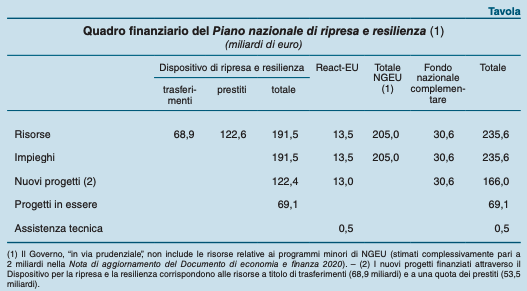Here are the purposes and effects of the NRP according to the Bank of Italy

The in-depth analysis on Next Generation Eu and Pnrr contained in the 2020 Annual Report of the Bank of Italy.
The Next Generation Eu (NgEu) program is the European Union's main response to the pandemic crisis. It provides for interventions up to 750 billion (of which 360 in loans and 390 in transfers) and is divided into different instruments, but the one with which most of the resources are managed is the Recovery and resilience device, which conveys 672.5 billions. To request the resources of the Facility, Member States must prepare national recovery and resilience plans, which define a coherent set of reforms and investments to be carried out between 2021 and 2026.
Italy recently presented its National Recovery and Resilience Plan (NRP) to the European Commission. Under the Device, interventions for 191.5 billion are envisaged (table), in addition to those financed by React-Eu (another Community program within the NgEu) and by national resources. Overall, the interventions of the NRP amounted to 235.6 billion; of these, according to the Government's assessments, approximately 166 billion euro are destined for new projects, almost half of which relate to European transfers; the rest finances interventions already planned.

The NRP identifies four general reforms, aimed respectively at increasing the efficiency of the public administration, speeding up the pace of justice, simplifying and rationalizing the legislative context and promoting competition; at the same time, numerous sectoral reform interventions are planned, also aimed at speeding up the execution of projects. The reform of the tax system and that of social safety nets contribute to the achievement of the general objectives of the Plan, although they are not an integral part of it.
The NRP is articulated along three strategic axes (digitization and innovation, ecological transition and social inclusion) and provides for three transversal priorities (gender equality, young people and overcoming territorial gaps). The first and second axes are assigned respectively 27 and 40 per cent of the resources disbursed through the Device, percentages higher than the minimum established by the European regulation of the instrument (20 and 37 per cent). The Government allocates to the South no less than 40 per cent of the resources of which a territorial distribution is possible (about 82 billion out of 206).
The interventions envisaged in the NRP are divided into six missions: (a) digitization, innovation, competitiveness, culture and tourism (to which 49.9 billion are destined); (b) green revolution and ecological transition (69.9 billion); (c) infrastructure for sustainable mobility (31.5 billion); (d) education and research (€ 33.8 billion); (e) inclusion and cohesion (€ 29.8 billion); (f) health (20.2 billion). The implementation of the NRP will be coordinated and monitored by the Ministry of Economy and Finance; the execution of the individual projects will instead be the responsibility of the Administrations (central or local) concerned. Evaluations based on the econometric model of the Bank of Italy indicate that the demand effects of the additional interventions of the Plan could raise the level of Italy's GDP to just under 2.5 per cent in 2024.
The average multiplier associated with these simulations, slightly higher than one, is consistent with interventions strongly concentrated in increases in public investments; however, it assumes that these are implemented promptly and that they are effective. A greater effect could be obtained if the investments increased the profitability of private capital, encouraging its accumulation and determining higher values of the multiplier. Based on a model that also allows us to consider the supply effects due to the complementarity between major public investments and private capital, the impact on output could expand to around 3.5 per cent of GDP in 2026; However, achieving this result requires a high efficiency of public capital.
Effects on long-term growth, beyond those included in these estimates, are achievable through the reforms envisaged in the NRP and through the incentive plans for research and innovation. By applying the methodology proposed in a recent paper in which the results of some previous reform interventions in Italy are estimated (see the box: The effects of reforms on productivity and growth: evidence for Italy in chapter 12), one can assess that, over a ten-year horizon, the measures contained in the NRP regarding competition and justice could lead to an increase in total factor productivity (TFP) of between about 1 and 2 percent, while incentives to favor research and the innovation contained in the national Transition 4.0 plan (financed for over 13 billion with the Funds of the Device) could increase the PTF between about 2 and 3 percent. This could translate into an effect on the level of GDP between about 3 and 6 percentage points over the ten years.
This is a machine translation from Italian language of a post published on Start Magazine at the URL https://www.startmag.it/economia/ecco-fini-ed-effetti-del-pnrr-secondo-la-banca-ditalia/ on Mon, 31 May 2021 12:58:55 +0000.
